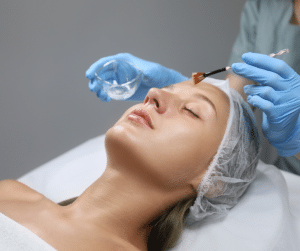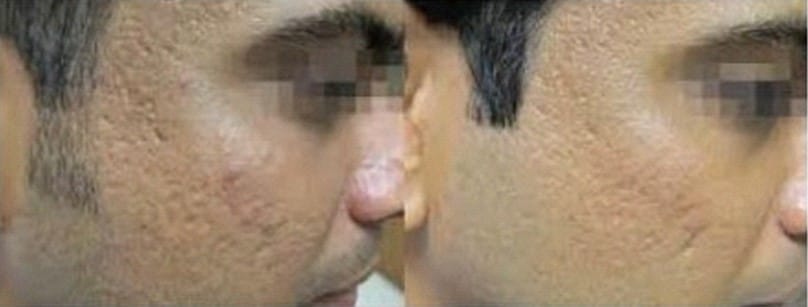Microneedling Acne Scar Treatment
Microneedling: One of The Best Choices For Acne Scarring Treatment
This is a common treatment used by many low-level clinics to treat acne scarring. The different types of microneedling range from derma-roller to derma-stamp to derma-pen. The needle lengths come in various sizes but usually are not long enough to treat deep acne scarring. Also, several treatments are needed to achieve some results. The downtime recovery is minimal and, therefore, suitable for patients. Most patients do not achieve the results they are looking for with this form of treatment and ultimately look for more aggressive treatments such as radiofrequency microneedling or laser resurfacing.

Radiofrequency micro-needling (Fractora)
What is FRACTORA, and what does it do?
Fractora is the most advanced fractional radiofrequency (RF) treatment, which may provide anti-ageing improvements to skin tone and texture for a more radiant appearance, through ablation and skin resurfacing. Ablative treatments do remove some skin, so they have more downtime than other non-ablative technologies like IPL.
Fractora delivers radiofrequency energy to the skin through an array of pins, producing localized heat and causing small micro-lesion dots in the acne scar treatment area. The gentle heat generated by the Fractora pins in the sub-dermal tissue may promote collagen restructuring for skin rejuvenation and may produce an improved appearance in the skin.
The methodical scattering of micro-lesions allows the skin to heal faster than if the entire area was ablated. What this means is that the majority of repair is being done under the skin, maximizing your results, but the damage to the surface is more minimal, allowing you to heal faster and better than with traditional resurfacing machines like Fraxel and CO2 technologies.
Fractora is designed to deliver targeted bipolar RF energy to various selectable depths in the skin. Fractora can meet or even exceed the results of fractional CO2 without the associated downtime, prolonged redness, and pigmentation drawbacks.
Fractora may achieve full-scale treatment depths with customizable fractional energy, which may improve a variety of skin problems ranging from superficial skin tone problems to deep textural concerns and acne scarring. Variable depths, densities and energy levels are used to give the possibility of results that were previously unattainable without excisional surgery.
This acne scar treatment delivers radiofrequency energy to the skin through several tiny pins, which produce localized heat and small 'micro-lesion' dots in the treatment area, creating a healing response and increasing collagen production. It is very effective for darker skin types where laser treatment may not be advisable.

Post Inflammatory Hyperpigmentation (PIH darkening of the skin)
Post Inflammatory hyperpigmentation (also called PIH) is a very common side effect. It is most common in darker skin types. It can be prevented or reduced by using skin-lightening creams such as kojic acid or hydroquinone. This is why Dr Sagoo will prep the skin several weeks before laser treatments to avoid the risk of hyperpigmentation. The hyperpigmentation can occur after laser treatments and can last anything from a few days to up to 6 months or more. Direct sunlight can make PIH worse, so we always advise strict sunblock application.
Hypopigmentation (loss of colour of normal skin)
One potential side effect of aggressive laser or chemical peels is that instead of improving the skin, there can be damage to the pigment-producing cells called melanin and, therefore, lead to loss of colour called hypopigmentation. This is more common in darker-skinned individuals.
On the face, this can be very visible and distressing. We are the only clinic in the UK that can re-pigment hypopigmentation using the excimer laser, and Dr. Sagoo receives many patients from all over the UK to re-pigment skin.
Infection
Infection can happen in any kind of laser resurfacing and lead to a viral infection such as herpes simplex (cold sore infection) when carrying out aggressive laser resurfacing, whether fractional or ablative, Dr Sagoo always prescribes anti-viral medication to avoid the risk of infection occurring.
Post-inflammatory erythema (PIE extended redness after laser treatment)
This is redness that can occur because of aggressive laser resurfacing or severe acne flares leading to red, inflamed skin and inflamed scars. The redness can last anything from a few weeks to up to 6 months but does usually fade and resolve. Some patients can be anxious about the redness, and we may use medical-grade camouflage creams. Sometimes, Dr. Sagoo may use a pulse dye laser or an intense pulsed light laser IPL to reduce and resolve the post-inflammatory redness with excellent results.
How does acne scarring occur?
Scarring can develop following acne, especially where nodules and cysts are a part of the disease. The inflammatory process in acne causes damage to the collagen scaffold of the skin, resulting in pitted acne scars (atrophic scars). Very rarely, in about 5% of cases, acne results in overgrown raised scars (hypertrophic scars).
What will microneedling acne scar treatment feel like?
For aggressive resurfacing with CO2 or Erbium YAG laser, Dr. Sagoo uses a combination of nerve blocks and tumescent anaesthesia coupled with a topical anaesthetic prep. Most areas of the face become completely numb, but some areas on the cheek and nose tip may have a little bit of breakthrough pain. For punch excision or medical Subcision, there is no pain as the local anaesthetic blocks injected beforehand make the somewhat aggressive treatments painless and comfortable for the patients.
After the laser procedure, you will feel a sunburn sensation, but this will completely settle after 24 hours. The main inconvenience for the first 3-4 days is ooze and swelling. Ibuprofen in the first 24 hours helps settle the burning sensation.
By day 4, the oozing will have settled. What now follows is a shedding of the dead skin layers, and this can be seen as fresh pink skin appearing. Sometimes, people get itchy at this stage. This can be helped by an antihistamine and a special cream that Dr Sagoo issues during the procedure.
By day eight most of the dead skin has come away. You will now look red/pink. This redness will persist but slowly reduce over the next 6-8 weeks. Makeup and foundation can be commenced cautiously on Day 10 after treatment. Foundation and SPF or a BB cream disguise redness nicely.
TCA cross, depending upon the strength of the acid used, can cause some temporary stinging, which resolves after 10 minutes with no pain afterwards. The downtime is 5-6 days. Medical subcision swelling and redness last for 1-2 days.
How long until my acne scars disappear?
During the initial consultation, Dr. Sagoo will determine the type of scarring, as this is vital in choosing the correct modality for the type of scar. If the scar is not correctly identified, as in most clinics, we see patients from, then the results are disappointing.
The majority of patients Dr Sagoo sees are failed acne scarring treatments from other clinics that do not have the expertise or the right tools to treat scarring. It is also important that before we treat acne scarring, the acne must be treated first until it is stable before commencing on acne scarring treatment.
Book Microneedling Acne Scar Treatment Today
Acne scarring can be a distressing condition, but with advancements in technology and expert care, there's hope for significant improvement. By understanding the different treatment options available, such as microneedling and Fractora, you can make an informed decision about your skincare journey.
It's essential to consult with a qualified cosmetic doctor to determine the most suitable approach for your specific concerns. Remember, patience and consistency are key to achieving optimal results.
To book a consultation and assessment of acne scarring, please call us on 03300 417494.
